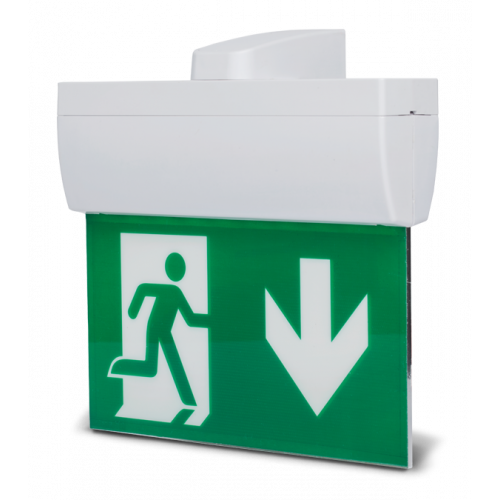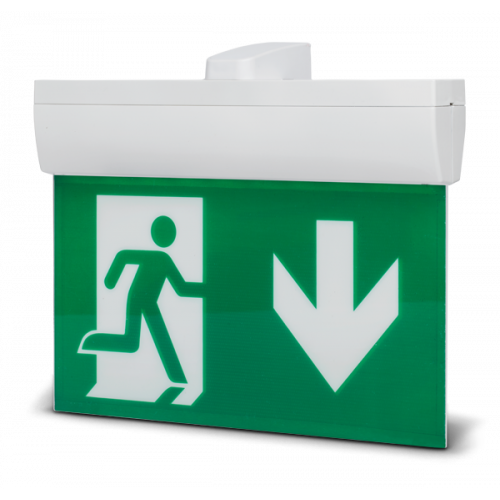Signalling luminaires for escape routes, compact and flexible, single bracket suits all mounting applications. Visibility distance 20 or 30 meters with international standard compliant safety signs (ISO7010).
Harper emergency luminaires
The lights can go out when least expected, for instance during extreme weather conditions, a fire hazard, work in progress or even network overload. In critical situations emergency luminaires provide crucial illumination and for occupants who must find their way out of a building.
Technology
The light source of the HARPER emergency luminaires series is an optimal blend of new generation long-life LEDs rated to over 50 thousand hours, high light output, low energy consumption and, thanks to an exclusive patented optical lighting design, highly effective glare-free technology that complies with all regulations regarding photobiological safety. The durability and performance of Harper emergency luminaires is further enhanced by new LiFePO4 long-life batteries which are smaller and more environment-friendly than standard nickel-cadmium or nickel-metal hydride batteries.Our selection
The Harper series offers a vast selection of LED lights for all emergency lighting needs. The various levels of autonomy, different protection grades which satisfy the requirements of all environments and accessory-device flexibility determine suitability for all applications. Two operating modes are available:
Maintained - The luminaire remains On continuously both when the mains power supply is present and when it is not. This is normally required for evacuation routes.
Non Maintained - The luminaire switches On only when there is a power cut on the mains power line.Versions
Standard Self-powered devices, complete with battery. Require connection to the 230Vac mains network only.Self-Test The emergency lighting devices are equipped with a microprocessor which manages the device (On/Off), its functions and its battery life. The device performs a FUNCTIONALITY TEST which runs every 14 days and a battery AUTONOMY TEST which runs every 28 days. In this way the installer can carry out regular maintenance in a precise and almost effortless way due to the fact that the lamp itself signals any faults that may be present. Bus-Supervised The devices are equipped with an interface which is electrically isolated from the rest of the electronic circuitry, this permits communication via BUS and therefore can be continuously monitored by a control panel. In all cases communication failure with the control panel (e.g. BUS Disconnected), the devices continue to function in a completely autonomous way and perform both the functionality and autonomy tests using the same procedure and times as the Self-Test. Central-Battery The devices are not equipped with batteries but have a circuit with an electronic driver for the activation of the LEDs. They can be powered by a voltage between 160 and 260Vac and can be used as ordinary luminaires or be connected to a centralized supervision system.Test button
Many HARPER devices are equipped with a button which provides the installer with numerous functions. By simply by pressing the button you can, at any moment, verify the device functionality or by pressing and holding the button for 5 seconds you can perform the autonomy test. In Maintained devices, pressing the button for 2 seconds will allow you to dim the Maintained light flow, from maximum brightness to minimum 10% intensity. This latter function is particularly useful for devices installed in public places such as cinemas and theatres: under normal circumstances these will provide enough light to indicate evacuation routes without disturbing the show. In the event of an emergency, these luminaires will provide the maximum light level.Inhibit and rest mode
The inhibit function, realized by means of a switch connected to the luminaire terminals, I and C, can be used to inhibit the emergency lighting system. However, this simple cost-efficient solution has a drawback: in the event of fault along the inhibit line, or if the switch is mistakingly left in the “OFF” position, the system will be permanently inhibited and consequently the light will be unable to switch on. As a countermeasure to these drawbacks the respective standards require a “Rest mode” which can be achieved by connecting an INICOM (centralized control device) to terminals R and C. The INICOM manages the Inhibit option on the luminaires and resets them in the event of blackout. This device allows you to carry out the functionality and autonomy test on the emergency system.

